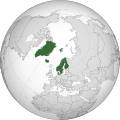Subdivisions of the Nordic countries
In today's world, Subdivisions of the Nordic countries is a topic that has gained unprecedented relevance. Whether in the scientific, social, political or cultural sphere, Subdivisions of the Nordic countries has become a point of interest and constant debate. With the advancement of technology and globalization, Subdivisions of the Nordic countries has taken on new dimensions and challenges, impacting the lives of millions of people around the world. In this article, we will explore different aspects related to Subdivisions of the Nordic countries, from its origins to its influence on today's society. We will analyze its importance in the current context and reflect on its future.
This article needs additional citations for verification. (May 2022) |
The administrative divisions of the Nordic countries are similar given the countries' shared culture and history.[citation needed]
Denmark
- Denmark proper
- 5 regions (Danish: regioner)
- 98 municipalities (Danish: kommuner)
- 2 autonomous insular overseas dependencies
Finland
- Finland
- 19 regions (Finnish: maakunnat, Swedish: landskap)
- Åland
- 70 sub-regions (Finnish: seutukunnat, Swedish: ekonomiska regioner)
- 310 municipalities (Finnish: kunnat, Swedish: kommuner)
- 19 regions (Finnish: maakunnat, Swedish: landskap)
Iceland
- Iceland
- 6 constituencies (Icelandic: kjördæmi), electoral
- 8 regions (Icelandic: landshlutar), statistical
- 64 municipalities (Icelandic: sveitarfélög), administrative
Norway
- Norway proper
- 11 counties (Norwegian: fylker)
- 356 municipalities (Norwegian: kommuner)
- overseas dependencies
Sweden
- Sweden
- 21 counties (Swedish: län)
- 290 municipalities (Swedish: kommuner)
References
- ^ Pihl, Roger (2019-08-07), "Regioner i Danmark", Store norske leksikon (in Norwegian Bokmål), retrieved 2022-05-12
- ^ "Nytt årtionde i Finlands 310 kommuner". Kommuntorget.fi (in Swedish). Retrieved 2022-05-12.
- ^ "Kjördæmi og kjörstaðir". stjornarradid.is (in Icelandic). Government of Iceland. Retrieved 20 February 2023.
- ^ "Landið allt" (in Icelandic). Samband íslenskra sveitarfélaga. Retrieved 20 February 2023.
- ^ "Nye fylker". Regjeringen.no (in Norwegian). 2019-12-19. Retrieved 2022-05-12.
- ^ "Noen fakta om nye kommuner fra 2020". KS (in Norwegian). Archived from the original on 2022-02-18. Retrieved 2022-05-12.
- ^ "Län och kommuner". Statistiska Centralbyrån (in Swedish). Retrieved 2022-05-12.
